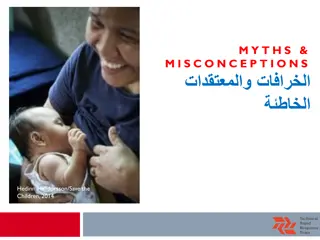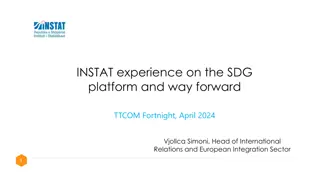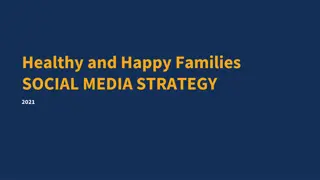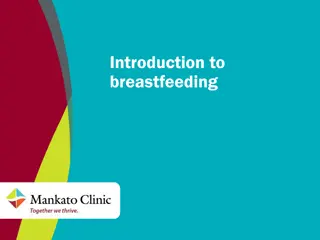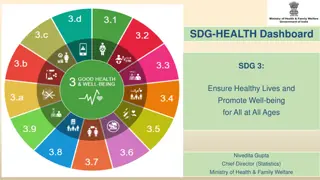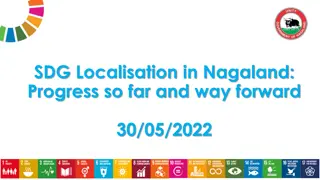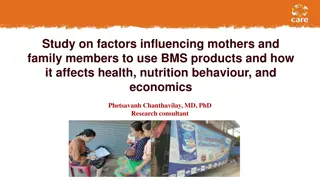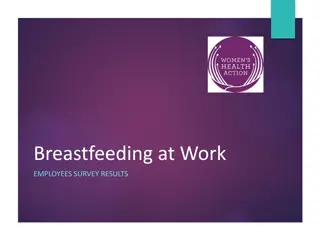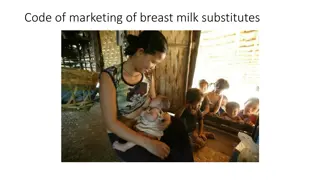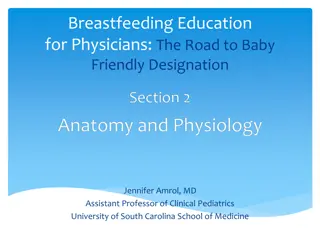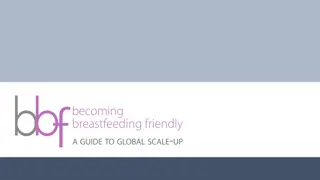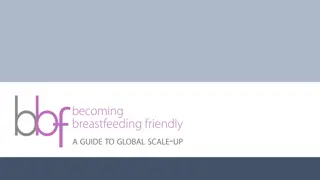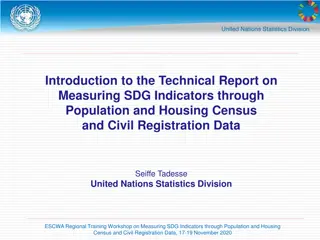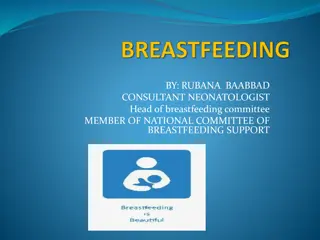Breastfeeding Trends and Progress Towards SDG Goals: WABA Commemoration 2024
Breastfeeding, a vital practice for infant health and development, is the focus of the 2024 World Alliance for Breastfeeding Action (WABA) Commemoration. Optimal breastfeeding practices, including early initiation, exclusive breastfeeding, and continued support, are essential for child nutrition and maternal well-being. The promotion of exclusive breastfeeding has shown improvement globally, with rates approaching the World Health Assembly target. Emphasizing the importance of sustained efforts to further enhance exclusive breastfeeding rates is crucial for meeting Sustainable Development Goals. Increased awareness and support are key to advancing breastfeeding practices for better child health outcomes.
Download Presentation

Please find below an Image/Link to download the presentation.
The content on the website is provided AS IS for your information and personal use only. It may not be sold, licensed, or shared on other websites without obtaining consent from the author.If you encounter any issues during the download, it is possible that the publisher has removed the file from their server.
You are allowed to download the files provided on this website for personal or commercial use, subject to the condition that they are used lawfully. All files are the property of their respective owners.
The content on the website is provided AS IS for your information and personal use only. It may not be sold, licensed, or shared on other websites without obtaining consent from the author.
E N D
Presentation Transcript
Commemoration of Breastfeeding Week (WABA) 2024: Are we on track to meeting the SDG Goals? ELIETH RUMANYIKA CHILD NUTRITION SPECIALIST
Introduction Breastfeeding, also known as nursing or Lactation, is the process where breast milk is fed to a child. Breast milk may be from the breast, or may be pumped and fed to the infant. Optimal breastfeeding practices are critical to the survival, good health, and development of young children. Breastfeeding supports children s growth and development and benefits mothers health. Recommended breastfeeding practices include; Early initiation of breastfeeding (within the first hour after birth), Exclusive breastfeeding for the first 6 months of life, Continued breastfeeding for 2 years and/or beyond (WHO and UNICEF 2021).
Initiation of breastfeeding within the first hour of birth is important for both the mother and the child. The first breast milk contains colostrum, which is highly nutritious and has antibodies that protect the newborn from infections Encourages bonding between the mother and her newborn, especially through skin-to-skin contact. Facilitates the production of breast milk 70%of children are breastfed within first hour of life WHY EARLY INITIATION OF BREASTFEEDING NOTE: Feeding newborns anything other than breast milk in the first 2 days after birth can delay early initiation of breastfeeding and interrupt exclusive breastfeeding and is not recommended unless medically indicated
Exclusive breastfeeding Exclusive breastfeeding Mixed feeding Exclusive breastfeeding means that the infant receives only breast milk. No other liquids or solids are given not even water with the exception of oral rehydration solution, or drops/syrups of vitamins, minerals or medicines prescribe by health specialist. Exclusive breastfeeding for the first 6 months lowers the risk of infections that can lead to diarrhea and respiratory illnesses and provides all of the nutrients and liquid an infant requires for optimal growth and development. Mixed milk feeding, in which children are fed both breast milk and formula or animal milk within the first 6 months, has the adverse effect of reducing breast milk output because the production of breast milk is modulated by the frequency and intensity of suckling. Mixed feeding under age 6 months also can increase children s risk of diarrhea, alter their intestinal microflora, and lead to early cessation of breastfeeding
EBF among children under 6 months has increased substantially over time, from 26% in 1991 92 to 64% in 2022 EBF is slightly higher in urban areas (67%) than in rural areas (63%) EBF is higher in Tanzania Mainland (65%) than in Zanzibar (41%) Trends in exclusive breastfeeding Globally rates of exclusive breastfeeding in the first six months of life have increased by 10 percentage points over the past decade and are at 48% for 2023, close to the World Health Assembly target of 50% by 2025 As a country we are encouraged to continue progressing towards higher rates in EBF SOURCE:TDHS 2022
CONTINUE BREASTFEEDING Breastfeeding should continue for the first 2 years or beyond because breast milk lowers children s risk of illness, promotes their recovery during illness, and remains an important source of nutrients for healthy growth and development. Longer durations of breastfeeding have many health benefits for women, including reducing risks of certain breast and ovarian cancers and diabetes. Only 62% of children aged 12 23 months, 62% are continued to be breastfeed and the % of breastfeeding declines sharply with increasing age, from 86% at 12 15 months to 35% at 20 23 month. continued breastfeeding is highest in Dodoma (84%) and lowest in Geita (42%) In order for children to meet their evolving nutritional requirements, infants should receive nutritionally adequate and safe complementary foods, while continuing to breastfeed for up to two years or beyond.
Initiatives to Improve BF and EBF AVAILABILITY OF NATIONAL IYCF GUIDELINE INITIATIVES FOR PROMOTING AND SUPPORTIN G BREASTFEE DING IMPLEMENTATION OF BABY FRIENDLY HOSPITAL INITIATIVE LEGISLATION AND WORKPLACE SUPPORT ADOPTION & IMPLEMENTATION OF INTERNATIONAL CODE OF MARKETING FOR BREASTMILK SUBSTITUTES COMMUNITY BASED PROGRAMS NUTRITION AND HEALTH EDUCATION MONITORING &EVALUATION OF BF INDICATORS
EXISTING POLICIES FOR BREASTFEEDING Tanzania's Health Sector Strategic Plan: This plan integrates nutrition and breastfeeding into its objectives, aiming to improve overall maternal and child health through various interventions and support systems. Workplace Breastfeeding Policies: Efforts have been made to create supportive environments for breastfeeding mothers in the workplace. This includes advocating for maternity leave policies and creating breastfeeding-friendly spaces in workplaces. National Multi-Sectoral Nutrition Action Plan: Focus on the strategic Outcome of improving nutrition status among children. Food and Nutrition Policy (Draft Review): It has a policy statement specifically on supporting exclusive breastfeeding and continue breastfeeding up to two years.
BREASTFEEDING AND SDG Breastfeeding is a central part of the 2030 Agenda for Sustainable Development and is linked to many of the Sustainable Development Goals (SDGs). Breastfeeding is a vital source of nutrition that can save children s lives and contribute to improved health outcomes for children and mothers(Goals 2 and 3 are concerned with hunger, health and well- being). Breastfeeding is associated with adding US$302 billion annually in additional income to the world economy nearly 0.5 per cent of world gross national industry (Goals 1, 8 & 10 focus on ending poverty, promoting economic growth and reducing inequalities).
BREASTFEEDING AND SDG The association between breastfeeding and higher IQs and educational attainment can contribute to efforts to achieving global learning targets(Goal 4 on education) Breastfeeding is linked to critical equality issues including birth spacing and workplace rights (Goal 5 on gender equality). Breastmilk does not require industry for production and is created and consumed with a minimal ecological footprint (Goals 12 tackles sustainable consumption).
Breastfeeding is a fundamental building block for sustainable development, providing a strong foundation for health, nutrition, and equality. By supporting breastfeeding, we not only nourish future generations but also advance multiple Sustainable Development Goals, from reducing child mortality to ensuring healthy lives and promoting lifelong well-being .
CLOSING THE GAP; SUPPORT BREASTFEEDING FOR ALL ASANTENI!!



